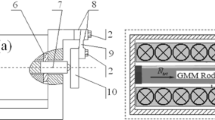Abstract
A giant magnetostrictive material (GMM) model is developed based on the hysteretic nonlinear theory. The Gram-Schmidt regression method is introduced to determine the parameters of the model as well as the relationship between the material strain and the strength and frequency of magnetic field in the model. Through comparison, it is shown that this regression method has good performance in significance test. Then the model is applied to study the motion law of a circular plate in classical GMM transducer, which helps control the transducer rapidly and accurately.
Similar content being viewed by others
References
Sablik M J, Jiles D C. A model for hysteresis in magnetostriction[J]. Journal of Applied Physics, 1998, 64(10): 5402–5404.
Callen E, Callen H B. The present status of the temperature dependence of magnetocrystalline anisotropy and the l(l+1)/2 power law[J]. Journal of Physics and Chemistry of Solids, 1966, 27(8): 1271–1285.
Han Tongpeng, Li Guoping. Magnetization-based hysteresis model for a giant magnetostrictive actuator[J]. Journal of Functional Materials and Devices, 2010, 16(1): 41–46 (in Chinese).
Weng Ling, Wang Bowen. Study of the output displacement control for a giant magnetostrictive actuator[J]. Chinese Journal of Scientific Instrument, 2006, 27(7): 800–803 (in Chinese).
Wang Bowen, Cao Shuying. Magnetostrictive properties of epoxy bonded Tb-Dy-Fe composites[J]. Journal of the Chinese Rare Earth Society, 2003, 21(6): 729–732 (in Chinese).
Weng Ling, Wang Bowen. Dynamic model of giant magnetostrictive transducer under magnetic field and stress[J]. Transactions of China Electrotechnical Society, 2008, 23(12): 17–22 (in Chinese).
Cao Shuying, Wang Bowen. Parameter identification of hysteretic model for giant magnetostrictive actuator using hybrid genetic algorithm[J]. Proceedings of the CSEE, 2004, 24(13): 127–134 (in Chinese).
Zhu Zhiwen, Wang Jin. Modeling of shape memory alloy based on hysteretic nonlinear theory[J]. Applied Mechanics and Materials, 2011, 44(47): 537–541.
Serneel S, Verdonck T. Principal component regression for data containing outliers and missing elements[J]. Computational Statistics and Data Analysis, 2009, 53(11): 3855–3863.
Parab J S, Gad R S. Noninvasive glucometer model using partial least square regression technique for human blood matrix[J]. Journal of Applied Physics, 2010, 107(10): 1–5.
Wang Huiwen, Chen Meiling. Gram-Schmidt regression and application in cutting tool abrasion prediction[J]. Journal of Beijing University of Aeronautics and Astronautics, 2008, 34(6): 729–733 (in Chinese).
Wang Jianxin, Wang Changsong. Forced vibration of a circular eradiation plate with a columned magnetostrictive actuator[J]. Journal of Vibration and Shock, 2009, 28(3): 164–167 (in Chinese).
Author information
Authors and Affiliations
Corresponding author
Additional information
Supported by Doctoral Programs Foundation of Ministry of Education of China (No. 200800561083).
WANG Hongli, born in 1945, female, Prof.
Rights and permissions
About this article
Cite this article
Wang, H., Zhang, Y. & Zhu, Z. Application of gram-schmidt regression to modeling of giant magnetostrictive material. Trans. Tianjin Univ. 18, 213–216 (2012). https://doi.org/10.1007/s12209-012-1665-1
Accepted:
Published:
Issue Date:
DOI: https://doi.org/10.1007/s12209-012-1665-1




